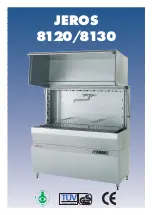
15
4. Turn on the pressure washer. Pull the trigger to operate the
unit.
m
CAUTION!
Always test the detergent in an
inconspicuous area before use.
5. Apply detergent from the bottom to the top of the dry
surface to be cleaned.
NOTE:
Wetting the surface first is not recommended as it
dilutes the detergent and reduces its cleaning ability.
6. Allow the detergent to remain on the surface for a short
time before rinsing. Do not allow the detergent to dry on
the surface.
m
CAUTION!
Damage may occur to painted surfaces if
the detergent is allowed to dry on the surface. Wash and rinse
a small section at a time. Avoid working on hot surfaces or in
direct sunlight.
m
CAUTION!
Failure to follow these cleaning instructions
will cause the injection system to become clogged and
inoperable.
Rinsing with the Pressure Washer
1.
Turn off the pressure washer, remove the bucket or shut
off the water supply.
2. Pull the trigger to release water pressure.
3. Lock the safety lock on the trigger handle by pushing on
the safety lock until it clicks into the slot.
4. Remove the soap dispenser attachment by pushing
firmly in while twisting it clockwise to unlock the tabs
and remove from the slots. Pull the attachment out of the
trigger gun.
5. Attach the spray wand onto the trigger gun.
6. Select the right nozzle for the job (Fig. 25).
I) The 0º intense-jet nozzle (orange) is an extremely
powerful nozzle that delivers a high-pressure, pencil-
point jet stream. It is used to cut heavy dirt deposits
in a small, concentrated area. It is ideal for dissolving
stubborn substances, like tar and grease spots on
concrete, or for removing caked mud from equipment.
Use this nozzle to clean hard-to-reach areas including
the facades of 2-story buildings or the undersides of
lawn mowers and tractors.
NOTE: Care should be used when choosing the
right nozzle to avoid permanently gouging wood or
damaging fragile surfaces.
II) Use the 15º fan-tip nozzle (yellow) for intense cleaning
jobs on hard surfaces. Applications include stripping
paint, removing oil stains, grease, heavy mildew stains,
and rust from steel. This nozzle should only be used in
areas that can withstand the high-pressure from this
nozzle.
III) Use the 25º fan-tip nozzle (green) to clean home siding,
brick patios, wood decks, driveways, or sidewalks.
When using this nozzle, test a small area first to avoid
surface damage.
IV) Use the 40º wide-spray tip nozzle (gray) to clean items
such as cars, trucks, boats, patio furniture, or lawn
equipment.
7. Lock the bucket with water on the base unit or connect
the base unit with a water supply. Start at the top of the
area to be rinsed and work your way down, making sure to
overlap your strokes.
m
IMPORTANT!
NEVER USE:
•
Bleach, chlorine products, and other corrosive chemicals
•
Liquids containing solvents (e.g. paint thinners, gasoline,
oils)
•
Tri-sodium phosphate products
•
Ammonia products
•
Acid-based products
These chemicals will harm the unit and will damage the
cleaning surface.
Shutting Down
1.
Press the On/Off button on the control panel.
2.
Pour the remaining water out from the bucket or turn off
the water source.
3. Hold the trigger to release water pressure.
4. If using the base unit directly, disconnect the garden hose
from the water inlet on the base unit.
5. Disconnect the high-pressure hose connection on the
trigger gun handle.
6. Release the trigger and lock the gun safety lock.
15º
SOA
P
25º
40º
0º
Fig. 25
Содержание SUNJOE SPX6000C-CT
Страница 21: ...NOTES 21 ...
Страница 22: ...NOTES 22 ...










































